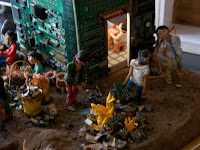
Monday, December 14, 2009
NPR: interview about contaminated water and its cause Dairy Farming

Thursday, December 3, 2009
House of Cards, Influence for my last project

Coral Bleaching
When corals lose their color, it is known as "coral bleaching". Coral bleaching became an issue when it was first observed on coral reefs in the South Pacific in the 1990's. Coral bleaching also occurs in saltwater reef aquariums. So what exactly is coral bleaching?
The skeletal structure of hard corals are normally white, but due to zooxanthellae algae, which are tiny plants called dinoflagellates (single-celled microscopic organisms which belong to the Protista kingdom) that reside within the soft tissues of corals, they have color. These microalgae are photosynthetic, and their relationship with some corals, as well as other marine life such as Tridanid clams, nudibranchs, some sponges and even jellyfishes, is an example of endosymbiosis (symbiosis - the intimate living together of two dissimilar organisms in a mutually beneficial relationship; endo - within).
Although long term bleaching can cause the partial or total death of coral colonies, if the situation is not too severe and stressful conditions are changed, it is possible for affected colonies to recover their symbiotic microalgae and start growing again.
Since stress seems to be the key to this problem occurring, let's evaluate what events are reported to be the cause of bleaching on coral reefs around the world.
The effects of el Nino and La Nina events.
What impact can these events have on marine ecosystems?
A change in ocean currents, which relates to changes in phytoplankton and zooplankton populations, as well the amount of other nutrients present in the water.
Increase/decrease in water temperatures.
Increase/decrease in water salinity.
Increase/decrease in air temperatures.
Build up of carbon dioxide and methane gases.
Exposure to increased ultraviolet radiation.
Exposure to high light levels.
Increased or high water turbulence.
Decrease in light levels.
Sedimentation, which relates to a decrease in light levels, as well as suffocation of sessile marine life.
Tuesday, December 1, 2009
Show at 21C Museum




Images from the show at the 21C Museum.




